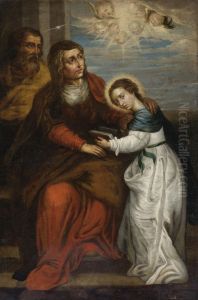Melchor Perez Holguin Paintings
Melchor Perez Holguin was a prominent painter during the colonial period of Bolivia, which at the time was part of the Viceroyalty of Peru. Born in the city of Cochabamba around 1660, Holguin is often considered one of the most important artists of the Andean baroque period. Unfortunately, details about his early life and training are somewhat obscure, but his works suggest that he was well-versed in the artistic techniques and styles popular in Europe during the 17th century.
Holguin's career is mainly associated with the city of Potosí, which was at the time one of the richest and most populous cities in the world due to its vast silver mines. The wealth of Potosí allowed for significant patronage of the arts, and Holguin benefited from this, receiving numerous commissions for religious paintings. His works were primarily intended for churches and religious institutions, and he became the leading painter in Potosí by the end of the 17th century.
The style of Holguin's paintings is characterized by the use of dramatic lighting, rich color, and intricate detail, elements that are typical of the Baroque style. He had a particular talent for depicting the textures of fabrics and the human figure, imbuing his subjects with a sense of grandeur and divine presence. Among his most notable works is the painting 'Virgin of the Rosary with Saints', which showcases his skillful use of chiaroscuro and his ability to create a sense of depth and volume.
Melchor Perez Holguin's legacy extends beyond his paintings; he is credited with influencing the Cusco School of artists who were active in the area during the same period. His work represents a fusion of European artistic principles with indigenous influences, which can be seen in his use of local iconography and the adaptation of European religious subjects to the Andean context.
Holguin died in Potosí in 1732, leaving behind a body of work that continues to be celebrated for its artistry and historical significance. His paintings are preserved in various museums and churches, primarily in Bolivia, and are studied as key examples of colonial Andean art.
